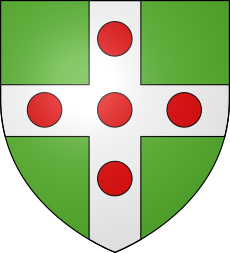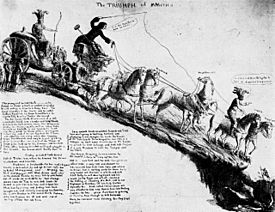George Grenville facts for kids
Quick facts for kids
George Grenville
|
|
|---|---|

Portrait by William Hoare, 1764
|
|
| Prime Minister of Great Britain | |
| In office 16 April 1763 – 10 July 1765 |
|
| Monarch | George III |
| Preceded by | The Earl of Bute |
| Succeeded by | The Marquess of Rockingham |
| Chancellor of the Exchequer | |
| In office 16 April 1763 – 16 July 1765 |
|
| Monarch | George III |
| Preceded by | Sir Francis Dashwood, Bt |
| Succeeded by | William Dowdeswell |
| Northern Secretary | |
| In office 27 May 1762 – 9 October 1762 |
|
| Prime Minister | The Earl of Bute |
| Preceded by | The Earl of Bute |
| Succeeded by | The Earl of Halifax |
| Member of Parliament for Buckingham |
|
| In office 1741 – 13 November 1770 |
|
| Preceded by | Richard Grenville |
| Succeeded by | James Grenville |
| Personal details | |
| Born | 14 October 1712 Wotton Underwood, England |
| Died | 13 November 1770 (aged 58) Mayfair, England |
| Resting place | All Saints Churchyard, Wotton Underwood |
| Political party | Whig (Grenvillite) |
| Spouses |
Elizabeth Wyndham
(m. 1749; died 1769) |
| Children | 8; including George and William |
| Parents |
|
| Alma mater | Christ Church, Oxford Eton College |
George Grenville (born October 14, 1712 – died November 13, 1770) was an important British statesman. He belonged to the Whig political group. He eventually became the Prime Minister of Great Britain.
Grenville came from a powerful political family. He first became a Member of Parliament (MP) for Buckingham in 1741. He was part of a group of young MPs called "Cobham's Cubs."
In 1754, Grenville became the Treasurer of the Navy. He held this job twice until 1761. Later, he became the Leader of the House of Commons. This caused some disagreement with his brother-in-law, William Pitt. Grenville then served as Northern Secretary and First Lord of the Admiralty.
On April 8, 1763, he became Prime Minister. His government worked to control public spending. They also focused on foreign policy. His most famous policy was the Stamp Act. This was a tax that was already used in Britain. Grenville extended it to the American colonies. However, this caused a lot of anger in America. The tax was later removed.
Grenville had a difficult relationship with his colleagues and with King George III. In 1765, the King removed him from office. He was replaced by Lord Rockingham. For the last five years of his life, Grenville led a group of his supporters in opposition. He also made up with William Pitt.
Contents
Early Life and Education
George Grenville was born at Wotton House on October 14, 1712. He was the second son of Richard Grenville and Hester Temple. Hester later became the 1st Countess Temple.
George was one of five brothers, and all of them became Members of Parliament. His sister, Hester Grenville, married the important political figure William Pitt. George's older brother was Richard Grenville.
His parents wanted George to become a lawyer. He went to Eton College and Christ Church, Oxford. He became a lawyer in 1735.
Political Career
Starting in Parliament
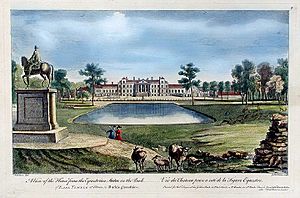
In 1741, George Grenville became a Member of Parliament (MP). He represented the area of Buckingham. He continued to be an MP for this area for 29 years until his death.
He joined a group in Parliament called the "Boy Patriots." This group was against Sir Robert Walpole, who was a powerful leader. Grenville was especially supported by Lord Cobham. Lord Cobham led a group that included George Grenville, his brother Richard, William Pitt, and George Lyttelton. This group became known as Cobham's Cubs.
Joining the Government
In December 1744, Grenville became a Lord of the Admiralty. This was part of the government led by Henry Pelham. He worked with his brother Richard and William Pitt. They pushed Pelham to give them better positions.
In June 1747, Grenville became a Lord of the Treasury. In 1754, he was made Treasurer of the Navy and a Privy Councillor. However, he and Pitt were removed from their jobs in 1755. This happened after they spoke against a treaty with Russia. They thought the treaty was too expensive and would get Britain involved in European problems.
Grenville and Pitt then joined the opposition. They criticized the government. They both supported creating a British militia (a citizen army) for security. They preferred this over using soldiers from other countries. When the government became weak, it had to resign in 1756.
Working with Pitt
Pitt then formed a new government. Grenville returned to his job as Treasurer of the Navy. He was a bit disappointed because he hoped for a more important role. This made him feel a growing dislike towards Pitt. He started to get closer to the young Prince of Wales and his advisor, Lord Bute.
In 1758, as Treasurer of the Navy, Grenville introduced a new law. This law created a fairer way to pay sailors' wages and support their families. He stayed in office during years when Britain won many victories, especially in 1759. This was a great year for the British government.
In 1761, Pitt resigned because of a disagreement about war with Spain. Grenville chose to stay in the government. He became the Leader of the House of Commons. This was seen as a way to keep someone close to Pitt involved in the government. However, it soon led to more disagreements between Grenville and Pitt.
Northern Secretary Role
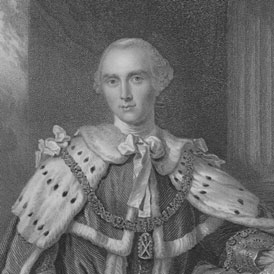
In May 1762, Grenville became the Northern Secretary. In this role, he took a tough stance in talks with France and Spain. These talks were about ending the Seven Years' War.
Grenville wanted Britain to get more in return for giving back land they had won. Lord Bute, the Prime Minister, wanted to be more generous. Bute's ideas eventually led to the Treaty of Paris. Even so, Grenville became more linked with Bute.
Lord Bute was very unpopular, so he offered to resign many times. King George III finally accepted Bute's resignation. In April 1763, Grenville became First Lord of the Treasury and Chancellor of the Exchequer. He took over from Bute as the main minister.
Prime Minister of Great Britain
Grenville's first big action as Prime Minister was to take legal action against John Wilkes. Wilkes had published an article in The North Briton newspaper. The article made fun of King George III's speech. Wilkes was accused of "seditious libel" (writing something harmful about the government). He later fled to France. Wilkes was elected to Parliament many times, but Parliament kept refusing to let him join. This caused problems for several governments.
Britain needed money after the Seven Years' War. They also needed money for the British army in the American colonies. So, Grenville's main job was to fix the country's finances. He also had to deal with Pontiac's Rebellion, a conflict in North America that started in 1763.
His government's main actions included the case against John Wilkes and passing the American Stamp Act. This tax caused the first major problems between the American colonies and Great Britain.
The Stamp Act
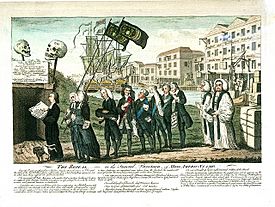
One of Grenville's most important actions was creating the Stamp Act in March 1765. It became law in November of that year. This was a special tax placed only on the American colonies. It required that all documents and newspapers be printed on special stamped paper from London. This paper had an official stamp that had to be paid for with British money.
The Stamp Act caused a lot of anger. It led to public protests and riots throughout the American colonies.
Foreign Policy
In disagreements with Spain and France, Grenville worked to achieve Britain's goals. He used what was called "gunboat diplomacy." This means showing military strength to get what you want.
During his time as Prime Minister, Britain became more isolated internationally. Britain failed to make alliances with other major European countries. This situation continued for later governments. It meant Britain fought several countries during the American War of Independence without a strong ally.
Dismissal from Office
King George III tried several times to get Pitt to form a new government, but it didn't work. Finally, the King asked Lord Rockingham. When Rockingham agreed to take the job, the King removed Grenville in July 1765. Grenville never held a government office again.
Grenville was sometimes called "gentle shepherd." This nickname came about because he kept asking during a debate, "Where should we put this new tax if not on cider?" William Pitt then whistled a popular song called Gentle Shepherd, tell me where, and everyone laughed. Grenville was very good at understanding Parliament's rules and managing details. However, he was not very good at dealing with people.
Later Political Life
After being Prime Minister, Grenville actively opposed the government led by Pitt from 1766 to 1768. In his last few years, he became an older, respected statesman. He tried not to be too closely linked with any one group in Parliament. He helped his main supporters get re-elected in the 1768 General Election. His followers included Robert Clive and Lord George Sackville. His older brother, Lord Temple, also supported him.
In late 1768, he made up with Pitt. They worked together again, just like before 1761. Grenville was successful in getting the opposition organized during the Middlesex election dispute.
Even though he personally disagreed with John Wilkes, Grenville believed the government's attempt to stop Wilkes from entering Parliament was against the rules. He opposed it based on this principle.
After France invaded Corsica in 1768, Grenville wanted Britain to help the Corsican Republic. He criticized the government for not stepping in. He thought that being weak would encourage the French. He said in Parliament, "For fear of going to war, you will make a war unavoidable."
In 1770, Grenville successfully guided a bill into law. This bill was about the results of disputed elections, which was a big problem in the 1700s. He did this despite strong opposition from the government.
George Grenville died on November 13, 1770, at the age of 58. After his death, his supporters split up. Some joined the government of Lord North. Later, the ideas of the Grenvillites were brought back by William Pitt the Younger. Pitt served as Prime Minister from 1784. Grenville's own son, William Grenville, also became Prime Minister for a short time. Grenville is buried at Wotton Underwood in Buckinghamshire.
Legacy and Family
George Grenville was one of the few Prime Ministers who never became a Lord.
The town of Grenville, Quebec, in Canada, was named after George Grenville. This town then gave its name to the Grenville orogeny. This was a very long period of mountain building that happened millions of years ago. It created a large mountain range across North America.
Family Life
In 1749, Grenville married Elizabeth Wyndham (1719 – December 5, 1769). She was the daughter of Sir William Wyndham.
George and Elizabeth had four sons and four daughters.
- Richard Grenville (died 1759), who died young.
- George Nugent-Temple-Grenville, 1st Marquess of Buckingham (1753–1813).
- Charlotte Grenville (around 1754 – 1830), who married Sir Watkin Williams-Wynn.
- Thomas Grenville (1755–1846), an MP and book lover, who never married.
- Elizabeth Grenville (1756–1842), who married John Proby, 1st Earl of Carysfort.
- William Grenville, 1st Baron Grenville (1759–1834), who later became Prime Minister.
- Catherine Grenville (1761–1796), who married Richard Neville-Aldworth.
- Hester Grenville (before 1767 – 1847), who married Hugh Fortescue, 1st Earl Fortescue.
At the time of his death in 1770, George Grenville was the next in line to inherit the title of Earl Temple. This title was held by his older brother Richard. When Richard died in 1779, George's second son, also named George, became the 3rd Earl Temple.
See also
 In Spanish: George Grenville para niños
In Spanish: George Grenville para niños
- Grenvillite


